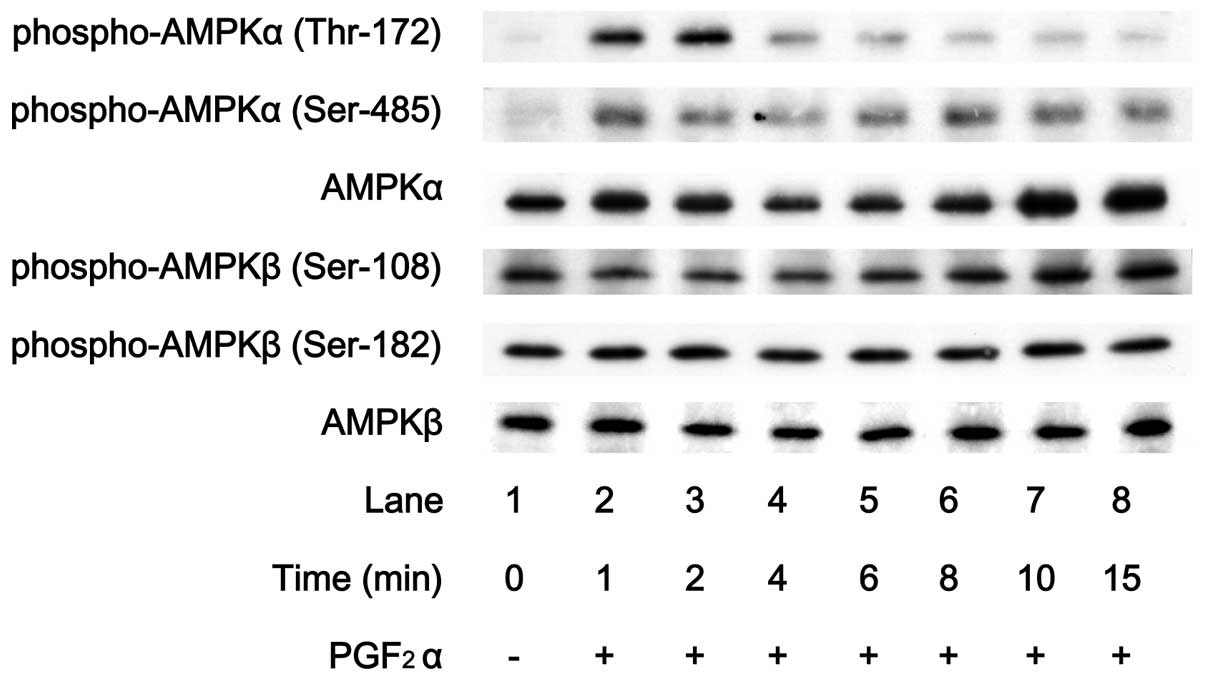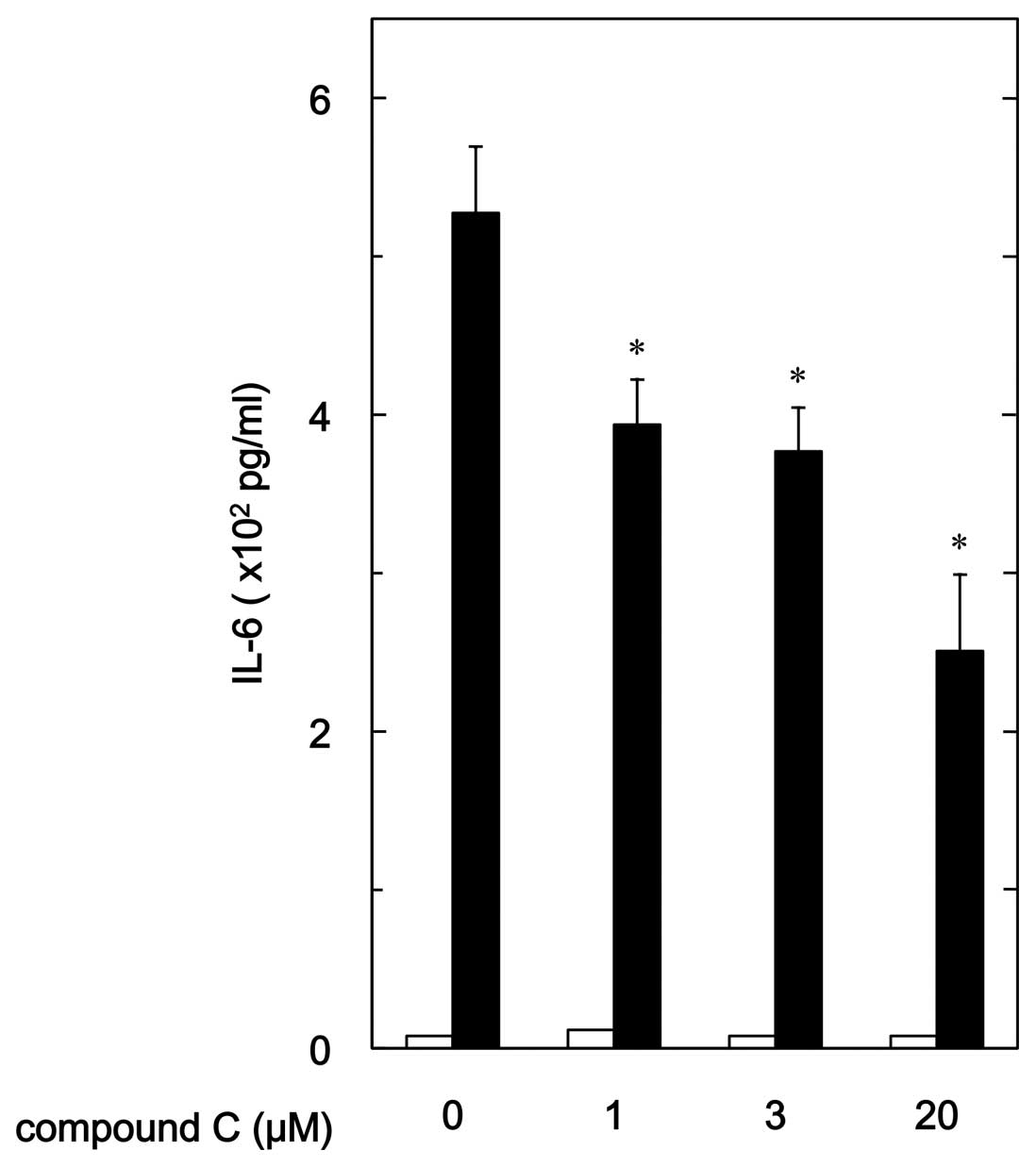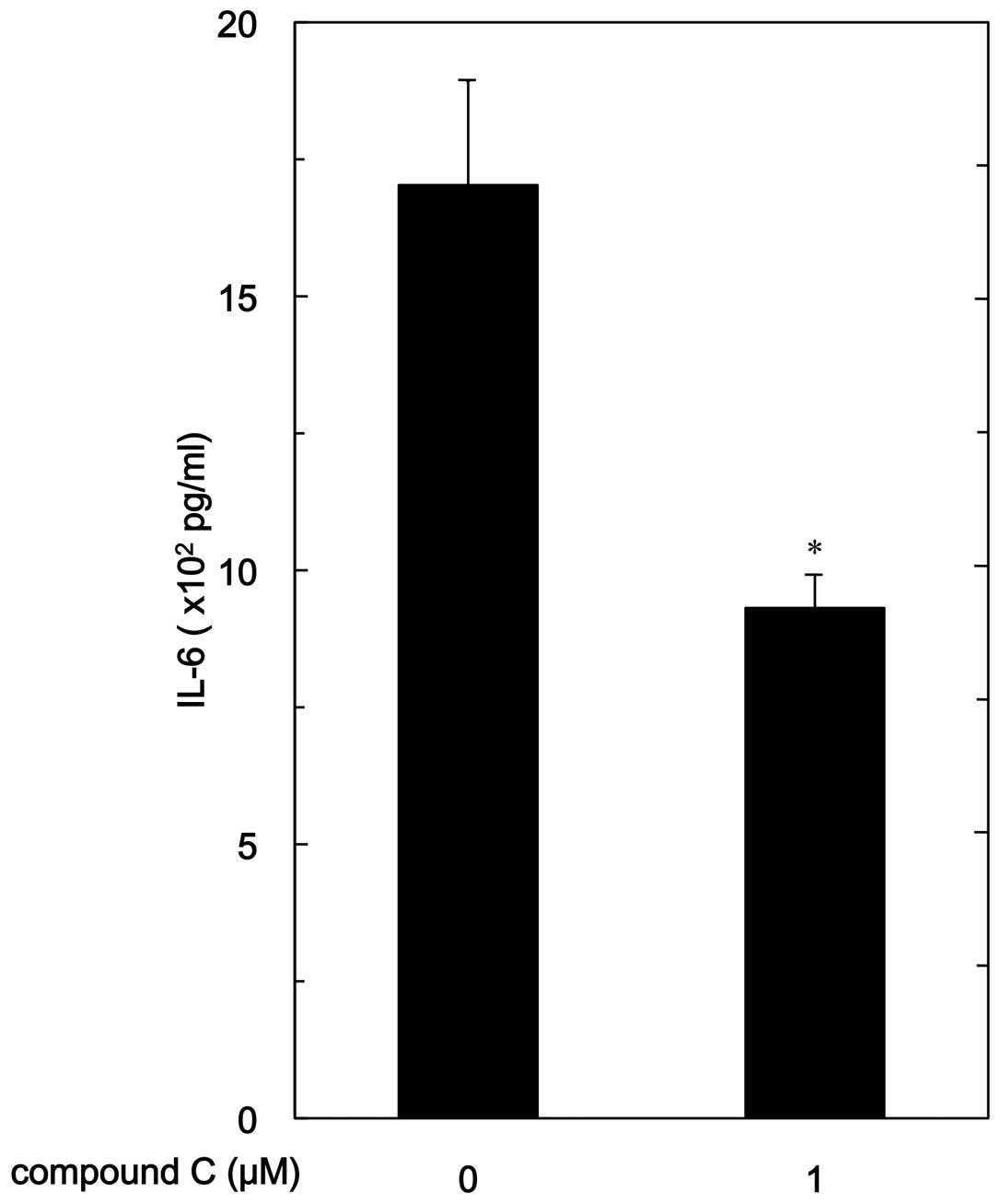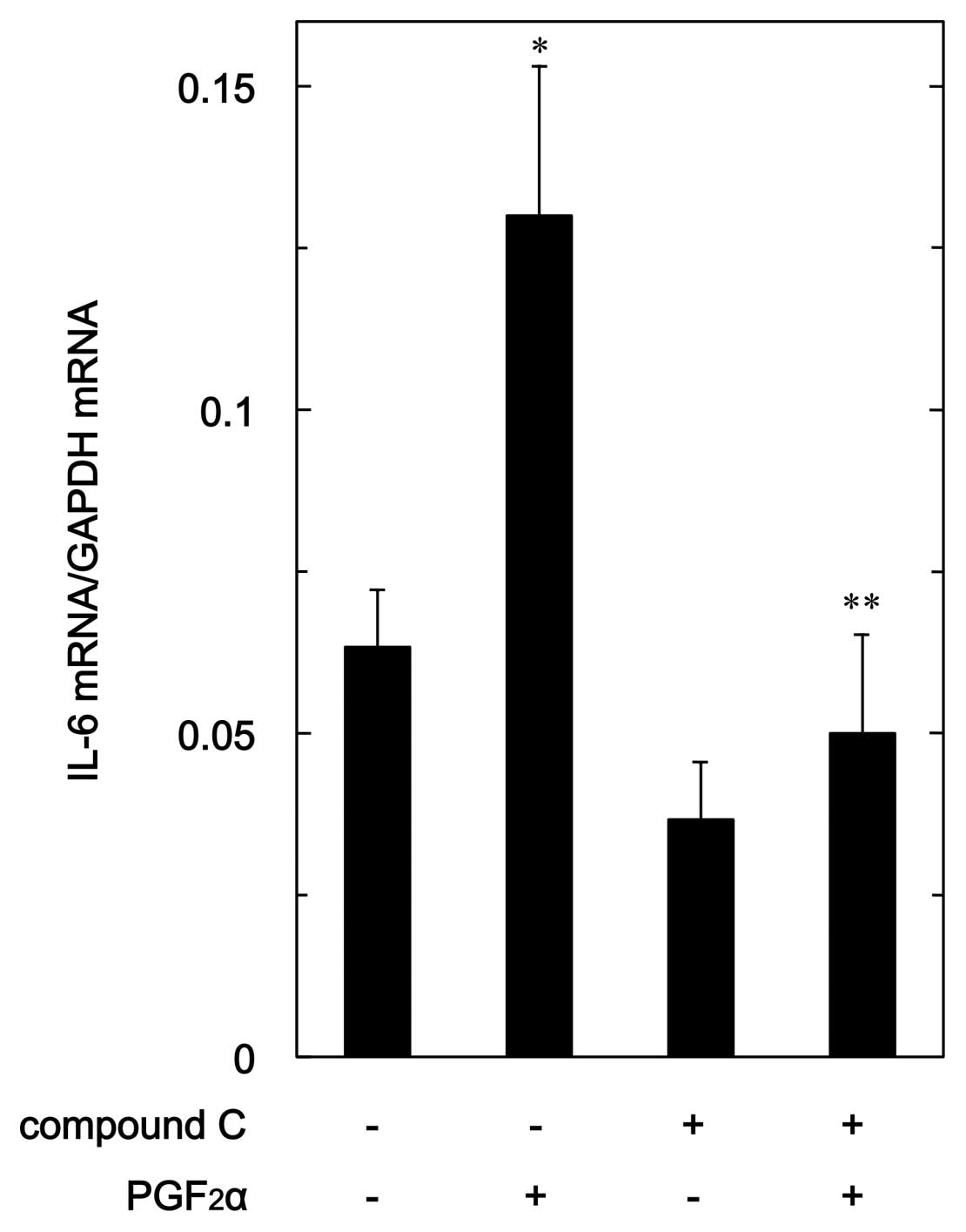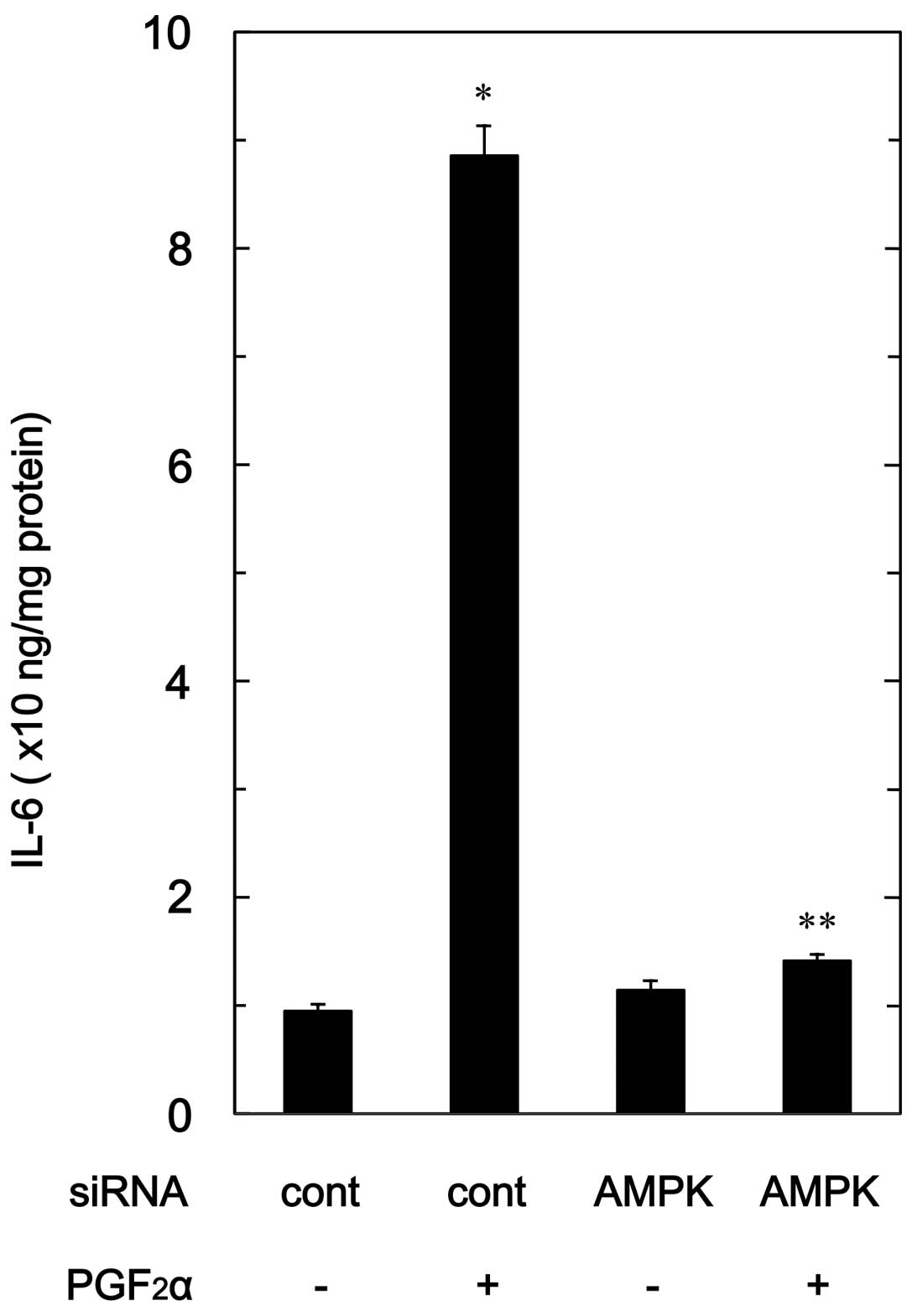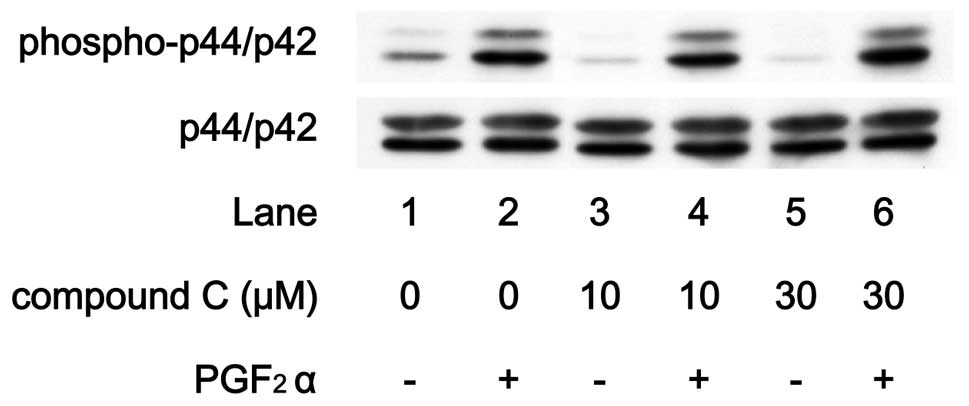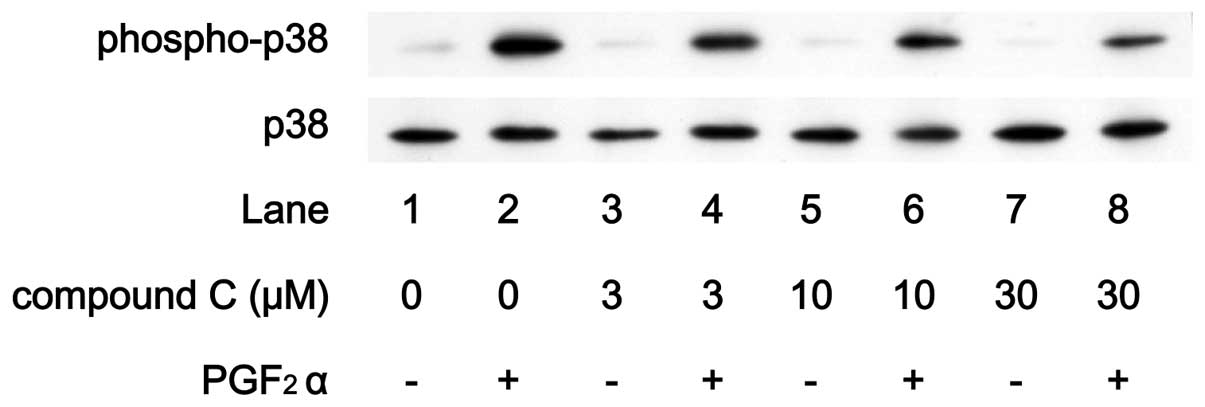AMP-activated protein kinase inhibitor decreases prostaglandin F2α-stimulated interleukin-6 synthesis through p38 MAP kinase in osteoblasts
- Authors:
- Published online on: October 15, 2012 https://doi.org/10.3892/ijmm.2012.1159
- Pages: 1487-1492
Abstract
Introduction
AMP-activated protein kinase (AMPK) is generally known to regulate multiple metabolic pathways (1). AMPK has been identified as a mammalian protein kinase that is allosterically activated by AMP and is able to phosphorylate and inactivate enzymes of lipid synthesis (1). It is currently recognized that AMPK is a key sensing enzyme involved in the regulation of cellular energy homeostasis (2–4). AMPK is activated in mammalian cells by a variety of physiological and pathological stresses that increase the intracellular AMP:ATP ratio, either by increasing ATP consumption or by decreasing ATP production. Activated AMPK acts to restore cellular energy balance by ATP-generating pathways such as fatty acid oxidation, while simultaneously inhibiting ATP-utilizing pathways. It is well recognized that bone metabolism is regulated mainly by two functional cells, osteoblasts and osteoclasts (5). The former cells are responsible for bone formation and the latter cells are responsible for bone resorption. These functional cells are closely coordinated via humoral factors or by direct cell-to-cell interaction (5,6). Regarding AMPK in bone metabolism, it has been shown that activated AMPK regulates bone formation and bone mass in vitro (7,8). In osteoblasts, activation of AMPK reportedly stimulates their differentiation and inhibits apoptosis (9,10). We previously showed that AMPK plays a role in vascular endothelial growth factor synthesis in osteoblast-like MC3T3-E1 cells (11). However, the exact role of AMPK in bone metabolism has not yet been elucidated.
It is well known that interleukin-6 (IL-6) is a multifunctional cytokine that has crucial effects on a variety of cell functions such as promoting B-cell differentiation, T-cell activation and inducing acute phase proteins (6,12,13). With regard to bone metabolism, IL-6 has been shown to promote osteoclast formation and stimulate bone resorption (6,13–15). It has been reported that potent bone resorptive agents such as tumor necrosis factor-α, IL-1 and prostaglandin (PG) E2 stimulate IL-6 synthesis in osteoblasts (14,16,17). Evidence suggests that IL-6, which is synthesized and secreted from osteoblasts, plays an important role as a downstream effector of bone resorptive agents in bone metabolism. It is well known that PGs act as autocrine/paracrine modulators of osteoblasts (18). Among them, prostaglandin F2α (PGF2α) is recognized to be a potent bone resorptive agent in bone metabolism. It has been reported that PGF2α stimulates the proliferation of osteoblasts and inhibits the differentiation (18). We previously reported that PGF2α stimulates the IL-6 synthesis in osteoblast-like MC3T3-E1 cells (19) and that p44/p42 mitogen-activated protein (MAP) kinase and p38 MAP kinase among the MAP kinase superfamily play a role in PGF2α-induced IL-6 synthesis in these cells (20,21). However, the detailed mechanism behind the PGF2α-stimulated IL-6 synthesis in osteoblasts remains to be clarified.
In the present study, we investigated the involvement of AMPK in PGF2α-stimulated IL-6 synthesis in osteoblast-like MC3T3-E1 cells. We herein showed that AMPK positively regulates PGF2α-stimulated IL-6 synthesis at a point upstream from p38 MAP kinase activation in these cells.
Materials and methods
Materials
PGF2α and mouse IL-6 enzyme-linked immunosorbent assay (ELISA) kit were purchased from R&D Systems, Inc. (Minneapolis, MN). Compound C was obtained from Calbiochem-Novabiochem Co. (La Jolla, CA). Normal human osteoblasts (NHOst) were purchased from Cambrex (Charles City, IA). Phospho-specific AMPK α-subunit (Thr-172), phospho-specific AMPK α-subunit (Ser-485), AMPK α-subunit, phospho-specific AMPK β-subunit (Ser-108), phospho-specific AMPK β-subunit (Ser-182), AMPK β-subunit, phospho-specific acetyl-CoA carboxylase, phospho-specific p44/p42 MAP kinase, p44/p42 MAP kinase, phospho-specific p38 MAP kinase and p38 MAP kinase antibodies were purchased from Cell Signaling Technology, Inc. (Beverly, MA). The GAPDH antibody was obtained from Santa Cruz Biotechnology, Inc. (Santa Cruz, CA). An ECL western blotting detection system was purchased from GE Healthcare UK, Ltd. (Buckinghamshire, UK). Control short interfering RNA (siRNA) (Silencer® Negative Control #1 siRNA) was purchased from Ambion (Austin, TX). AMPK α1-subunit siRNA (SI0 1388219) and the OmniScript Reverse Transcriptase kit were purchased from Qiagen GmbH (Hilden, Germany). siLentFect™ was purchased from Bio-Rad (Hercules, CA). TRIzol reagent was purchased from Invitrogen (Carlsbad, CA). Fast Start DNA Master SYBR-Green I was purchased from Roche Diagnostics (Mannheim, Germany). Other materials and chemicals were obtained from commercial sources.
Cell culture
Cloned osteoblast-like MC3T3-E1 cells that were derived from newborn mouse calvaria (22) were maintained as previously described (23). Briefly, the cells were cultured in α-minimum essential medium (α-MEM) containing 10% fetal calf serum (FCS) at 37°C in a humidified atmosphere of 5% CO2/95% air. The cells were seeded into 35-mm (5×104) or 90-mm (2×105) diameter dishes in α-MEM containing 10% FCS. After 5 days, the medium was replaced with α-MEM containing 0.3% FCS. The cells were used for experiments after 48 h.
NHOst were seeded into 35-mm (5×104) diameter dishes in α-MEM containing 10% FCS. After 6 days, the medium was replaced with α-MEM containing 0.3% FCS. The cells were used for experiments after 48 h.
IL-6 assay
The cultured cells were stimulated with 10 μM PGF2α in 1 ml of α-MEM containing 0.3% FCS for the indicated periods. When indicated, the cells were pretreated with various doses of compound C for 60 min. The conditioned medium was collected at the end of the incubation and the IL-6 concentration was measured by the IL-6 ELISA kit.
siRNA transfection
To knock down the AMPK α-subunit in MC3T3-E1 cells, the cells were transfected with the control siRNA or the AMPK α1-subunit siRNA using siLentFect according to the manufacturer’s protocol. In brief, the cells (1×105) were seeded in a 35-mm diameter dish in α-MEM containing 10% FCS and subcultured for 48 h. The cells were then incubated with 50 nM siRNA-siLentFect complexes. After 24 h, the medium was replaced with α-MEM containing 0.3% FCS. The cells were used for experiments after 24 h.
Western blot analysis
Western blot analysis was performed as previously described (24). The cultured cells were stimulated with PGF2α or vehicle in α-MEM containing 0.3% FCS for the indicated periods. When indicated, the cells were pretreated with various doses of compound C for 60 min. The cells were washed twice with phosphate-buffered saline and then lysed, homogenized and sonicated in a lysis buffer containing 62.5 mM Tris/HCl (pH 6.8), 3% sodium dodecyl sulfate (SDS), 50 mM dithiothreitol and 10% glycerol. The cytosolic fraction was collected as a supernatant after centrifugation at 125,000 × g for 10 min at 4°C. SDS-polyacrylamide gel electrophoresis (PAGE) was performed according to Laemmli et al (25) on 10% polyacrylamide gel. The protein (20 μg) was fractionated and transferred onto an Immun-Blot® PVDF Membrane (Bio-Rad, Hercules, CA). Membranes were blocked with 5% fat-free dry milk in Tris-buffered saline-Tween [TBS-T; 20 mM Tris/HCl (pH 7.6), 137 mM NaCl, 0.1% Tween-20] for 2 h before incubation with the primary antibodies. Phospho-specific AMPK α-subunit (Thr-172), phospho-specific AMPK α-subunit (Ser-485), AMPK α-subunit, phospho-specific AMPK β-subunit (Ser-108), phospho-specific AMPK β-subunit (Ser-182), AMPK β-subunit, phospho-specific acetyl-CoA carboxylase, phospho-specific p44/p42 MAP kinase, p44/p42 MAP kinase, phospho-specific p38 MAP kinase, p38 MAP kinase, phospho-specific SAPK/JNK and SAPK/JNK antibodies or GAPDH antibody were used as primary antibodies. Peroxidase-labeled antibody raised in goat against rabbit IgG (KPL, Inc., Gaithersburg, MD) was used as the secondary antibody. The primary and secondary antibodies were diluted at 1:1,000 with 5% fat-free dry milk in TBS-T. Peroxidase activity on the membrane was visualized on X-ray film by means of the ECL western blotting detection system.
Real-time RT-PCR
The cultured cells were stimulated with 10 μM PGF2α for the indicated periods. Total RNA was isolated and transcribed into cDNA using TRIzol reagent and the OmniScript Reverse Transcriptase kit. Real-time RT-PCR was performed using a Light Cycler system (Roche Diagnostics, Basel, Switzerland) in the capillaries and Fast Start DNA Master SYBR-Green I provided with the kit. Sense and antisense primers for mouse IL-6 and GAPDH mRNA were purchased from Takara Bio, Inc. (Tokyo, Japan) (primer set ID MA039013). The amplified products were determined by a melting curve analysis and agarose electrophoresis. IL-6 mRNA levels were normalized with those of GAPDH mRNA.
Determination
The absorbance of enzyme immunoassay samples was measured at 450 nm with an EL 340 Bio Kinetic Reader (Bio-Tek Instruments, Inc., Winooski, VT).
Statistical analysis
Data were analyzed by ANOVA followed by the Bonferroni method for multiple comparisons between pairs and a P<0.05 was considered to indicate a statistically significant difference. All data are presented as the means ± SEM of triplicate independent determinations.
Results
Effect of PGF2α on the phosphorylation of AMP-activated protein kinase in MC3T3-E1 cells
It is generally known that the phosphorylation of AMPK is essential for its activation (26). Therefore, we first examined the effect of PGF2α on the phosphorylation of AMPK in osteoblast-like MC3T3-E1 cells in order to clarify whether PGF2α induces the activation of AMPK in osteoblasts. PGF2α markedly stimulated the phosphorylation of the AMPK α-subunit (Thr-172) (Fig. 1). In contrast, levels of phosphorylated AMPK β-subunit (Ser-108) or phosphorylated AMPK β-subunit (Ser-182) were barely affected by PGF2α (Fig. 1). The effect of PGF2α on the phosphorylation of AMPK α-subunit (Thr-172) reached its peak within 2 min and thereafter decreased.
Effect of compound C on PGF2α-stimulated IL-6 release in MC3T3-E1 cells
In our previous study (19), we showed that PGF2α stimulates IL-6 synthesis in osteoblast-like MC3T3-E1 cells. In order to investigate whether AMPK plays a role in PGF2α-induced synthesis of IL-6 in MC3T3-E1 cells, we examined the effect of compound C, an inhibitor of AMPK (27), on the PGF2α-stimulated release of IL-6. Compound C significantly reduced PGF2α-stimulated IL-6 release (Fig. 2). The suppressive effect of compound C on the IL-6 release was dose-dependent in the range between 1 and 20 μM. Twenty micromoles of compound C caused an ∼55% inhibition in the PGF2α effect.
Effects of PGF2α on the phosphorylation of acetyl-CoA carboxylase in MC3T3-E1 cells
Acetyl-CoA carboxylase, which regulates lipid synthesis, is a direct substrate of AMPK (1). PGF2α markedly induced the phosphorylation of acetyl-CoA carboxylase in MC3T3-E1 cells (Fig. 3). The effect of PGF2α on acetyl-CoA carboxylase phosphorylation reached a peak within 6 min and thereafter decreased. Compound C reduced the PGF2α-induced phosphorylation level of acetyl-CoA carboxylase in a dose-dependent manner (Fig. 4).
Effect of compound C on the PGF2α-stimulated IL-6 release in human osteoblasts
In addition, we examined the effect of compound C (27), on PGF2α-induced release of IL-6 in another type of osteoblast, NHOst, a human osteoblastic cell type. We found that PGF2α markedly stimulated IL-6 release in NHOst. Compound C significantly suppressed the PGF2α-induced release of IL-6 (Fig. 5). Compound C (1 μM) caused an ∼45% inhibition in the PGF2α effect.
Effect of compound C on the PGF2α-stimulated IL-6 mRNA expression in MC3T3-E1 cells
In order to clarify whether the suppression of PGF2α-stimulated IL-6 synthesis by compound C is mediated via a transcriptional event, we examined the effect of compound C on PGF2α-induced expression level of IL-6 mRNA in MC3T3-E1 cells. Compound C, which alone had a slight suppressive effect on the basal IL-6 mRNA expression level, significantly reduced the PGF2α-induced level of IL-6 mRNA (Fig. 6).
Effect of AMPK siRNA on PGF2α-stimulated IL-6 release in MC3T3-E1 cells
To confirm the findings from the compound C experimental series in osteoblast-like MC3T3-E1 cells, we examined the effect of AMPK downregulation by siRNA on the PGF2α-stimulated IL-6 release. PGF2α-induced levels of IL-6 in AMPK α1-subunit-downregulated cells were markedly suppressed compared with levels in the control siRNA-transfected cells (Fig. 7).
Effects of compound C on PGF2α-induced phosphorylation of p44/p42 MAP kinase or p38 MAP kinase in MC3T3-E1 cells
The MAP kinase superfamily such as p44/p42 MAP kinase, p38 MAP kinase and stress-activated protein kinase/c-Jun N-terminal kinase (SAPK/JNK) plays a central role in the transduction of the various messages of a variety of agonists (28). In our previous studies (20,21), we demonstrated that PGF2α induces the activation of p44/p42 MAP kinase, p38 MAP kinase and SAPK/JNK in osteoblast-like MC3T3-E1 cells and that p44/p42 MAP kinase and p38 MAP kinase but not SAPK/JNK function as positive regulators in PGF2α-stimulated IL-6 synthesis. In order to elucidate whether the AMPK effect on PGF2α-stimulated IL-6 synthesis is due to the activation of these MAP kinases in MC3T3-E1 cells, we examined the effect of compound C on PGF2α-induced phosphorylation of p44/p42 MAP kinase or p38 MAP kinase. PGF2α-induced phosphorylation of p44/p42 MAP kinase was not suppressed by compound C up to 30 μM (Fig. 8). On the contrary, compound C markedly attenuated the PGF2α-induced phosphorylation level of p38 MAP kinase in a dose-dependent manner in the range between 3 and 30 μM (Fig. 9).
Discussion
In the present study, we showed that PGF2α markedly stimulated the phosphorylation of AMP-activated protein kinase (AMPK) α-subunit (Thr-172) among the phosphorylation sites of AMPK in osteoblast-like MC3T3-E1 cells. It is generally recognized that AMPK plays a crucial role as a central regulator of cellular energy homeostasis (2). AMPK is a heterotrimeric complex that consists of three subunits, α, β and γ (26,29). Among the three subunits of AMPK, the α-subunit is recognized to be a catalytic site whereas β- and γ-subunits are considered as regulatory sites. It has been reported that the phosphorylation of the AMPK α-subunit at Thr-172 is essential for enzyme activation (26). We also showed that PGF2α induced acetyl-CoA carboxylase phosphorylation in MC3T3-E1 cells. Acetyl-CoA carboxylase is a downstream target of AMPK, and phosphorylated acetyl-CoA carboxylase inhibits the synthesis of lipids such as fatty acid and cholesterol (1,26). We demonstrate that the time course of PGF2α-induced phosphorylation of the AMPK α-subunit at Thr-172 was more rapid than that of acetyl-CoA carboxylase (Figs. 1 and 3). In addition, we showed that compound C, an inhibitor of AMPK (27), reduced the levels of acetyl-CoA carboxylase phosphorylation induced by PGF2α. Based on our findings, it is most likely that PGF2α stimulates the activation of AMPK in osteoblast-like MC3T3-E1 cells.
We next investigated whether AMPK activation plays a role in PGF2α-stimulated IL-6 synthesis in osteoblast-like MC3T3-E1 cells. Compound C significantly inhibited the PGF2α-stimulated release of IL-6 in a dose-dependent manner. These findings suggest that the AMPK activated by PGF2α is involved in IL-6 synthesis in MC3T3-E1 cells. In addition, we showed that compound C markedly inhibited PGF2α-induced IL-6 mRNA expression. It is likely that AMPK regulates the synthesis of IL-6. Additionally, we found that compound C suppressed the IL-6 levels stimulated by PGF2α in NHOst, a human osteoblast cell type. Thus, it is probable that the effect of compound C on PGF2α-induced IL-6 synthesis is common in mammalian osteoblasts. Furthermore, we demonstrated that downregulation of AMPK by siRNA markedly reduced the PGF2α-stimulated IL-6 release in MC3T3-E1 cells. Taking our results into account, it is likely that PGF2α stimulates the activation of AMPK in osteoblast-like MC3T3-E1 cells and that AMPK positively regulates PGF2α-induced IL-6 synthesis.
In our previous studies (20,21), we reported that p44/p42 MAP kinase and p38 MAP kinase but not SAPK/JNK among the MAP kinase superfamily act as positive regulators in PGF2α-stimulated IL-6 synthesis in osteoblast-like MC3T3-E1 cells. Therefore, we investigated the relationship between AMPK and MAP kinase signaling, p44/p42 MAP kinase or p38 MAP kinase in IL-6 synthesis. Compound C markedly suppressed PGF2α-induced phosphorylation levels of p38 MAP kinase without affecting the levels of p44/p42 MAP kinase phosphorylation. These findings suggest that AMPK functions in the PGF2α-stimulated activation of p38 MAP kinase in osteoblast-like MC3T3-E1 cells. In the present study, we showed that the maximum effect of PGF2α on the phosphorylation of the AMPK α-subunit (Thr-172) was observed within 2 min after stimulation. In contrast, in our previous study (30), we showed that the phosphorylation of p38 MAP kinase reached a peak at 10 min after the stimulation of PGF2α. The time course of PGF2α-induced phosphorylation of AMPK appears to be more rapid than that of p38 MAP kinase. Therefore, it is reasonable that PGF2α induces the activation of p38 MAP kinase via AMPK in MC3T3-E1 cells. Collectively, PGF2α stimulates IL-6 synthesis via AMPK, which plays a role at least partly through the regulation of p38 MAP kinase in osteoblast-like MC3T3-E1 cells.
AMPK is a central regulator in cellular energy homeostasis such as lipid synthesis (1,31). With regard to bone metabolism, accumulating evidence suggests that AMPK stimulates bone formation and mineralization, resulting in an increase in bone mass (7,8). As for osteoblast function, it has recently been shown that the activation of AMPK inhibits palmitate-induced apoptosis in osteoblasts (9). AMPK was reported to stimulate osteoblast differentiation via induction of Runx2 expression (10). In addition, it has recently been shown that inhibition of AMPK suppresses osteoprotegerin secretion in osteoblasts (32). Based on our present findings, it is possible that inhibition of AMPK reduces the PGF2α-stimulated IL-6 synthesis in osteoblasts. Osteoporosis is a major clinical problem in advanced countries. The pathology of osteoporosis involves the reduction in bone mineral density, resulting in susceptibility to bone fracture (33). IL-6 synthesized by osteoblasts is generally recognized as a potent bone resorptive agent and induces osteoclast formation (6,14). Therefore, we speculate that PGF2α-activated AMPK in osteoblasts is a potent modulator in bone metabolism via the fine-tuning of the local cytokine network, such as synthesis of IL-6. The appropriate regulation of AMPK in osteoblasts may be a potential molecular therapeutic strategy for bone metabolic disease such as osteoporosis. However, the detailed mechanisms of AMPK in bone metabolism are not precisely known. Further investigation is necessary to clarify the exact roles of AMPK in osteoblasts.
Taken together, our results revealed that an AMPK inhibitor decreases PGF2α-stimulated IL-6 synthesis via suppression of p38 MAP kinase in osteoblasts.
Acknowledgements
We are grateful to Yoko Kawamura for her skillful technical assistance. This investigation was supported in part by a Grant-in-Aid for Scientific Research (16590873 and 16591482) for the Ministry of Education, Science, Sports and Culture of Japan, the Foundation for Growth Science and the Research Funding for Longevity Sciences (21-4, 22-4 and 23-9) from the National Center for Geriatrics and Gerontology (NCGG), Japan.



